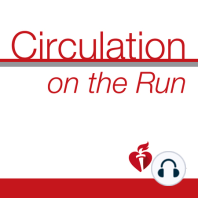18 min listen
Circulation March 27, 2018 Issue
ratings:
Length:
26 minutes
Released:
Mar 26, 2018
Format:
Podcast episode
Description
Dr Carolyn Lam: Welcome to Circulation on the Run, your weekly podcast summary and backstage pass to the journal and its editors. I'm Dr. Carolyn Lam, associate editor from the National Heart Centre and Duke National University of Singapore. Our featured paper this week is an in-depth paper on the cardiovascular and metabolic heterogeneity of obesity, and we will have a discussion with the authors on the clinical challenges, implications for management, and much more coming right up after these summaries. How does MRI quantification compare with standard Doppler echo approach to identify organic mitral regurgitation and predict adverse outcomes? Well, our first paper this week addresses this question, led by first and corresponding author, Dr. Penicka from the Cardiovascular Center OLV Clinic in Belgium. These authors studied 258 asymptomatic patients with preserved left ventricular ejection fraction and chronic moderate and severe organic mitral regurgitation by echo. All patients underwent MRI to quantify regurgitant volume of this organic mitral regurgitation by subtracting aortic flow volume from the total left ventricular stroke volume. Severe organic mitral regurgitation was defined as a regurgitant volume of greater or equal to 60 milliliters. The authors found that mean echo-derived regurgitant volume was an average 17 milliliters larger than the MRI-derived regurgitant volume. Concordant grading of organic mitral regurgitation severity with both techniques was observed in 76% of individuals. In the remaining 24% of individuals with discordant findings between the two techniques, this was mainly observed in patients with late systolic, eccentric, or multiple jets. The MRI-derived regurgitant volume showed the highest discriminative power among all the imaging parameters to predict all cause mortality or its combination with development of indication for mitral valve surgery. Thus, this study demonstrates that MRI-derived assessments of organic mitral regurgitation are clinically accurate to identify asymptomatic patients with severe organic mitral regurgitation and at first outcomes. This may be particularly so when the mitral regurgitation is late systolic, eccentric, or multiple in jets where misclassification may occur with echo-derived approach. The next study is the first large population-based study to analyze the association between low-dose ionizing radiation from cardiac procedures and incident cancer in adults with congenital heart disease. First author Dr. Cohen, corresponding author Dr. Marelli from McGill University, studied the population from the Quebec Congenital Heart Disease Database and performed a nested case control study comparing cancer cases with controls matched on sex, congenital heart disease severity, birth year, and age. They found that the cumulative incidence of cancer in adults with congenital heart disease between the ages of 18 and 64 years was 15%. The cumulative low-dose ionizing radiation exposure from cardiac procedures was independently associated with incident cancer after adjusting for age, sex, year of birth, congenital heart disease severity and comorbidities. Results were similar using either the number of procedures or estimates of the effective doses with a possible dose-related response relationship between the low-dose ionizing radiation exposure level and cancer risk. Thus, increasing exposure to low-dose ionizing radiation from cardiac imaging in adults with congenital heart disease raises concerns about life-long risk of malignancy. Confirmation of these findings by prospective studies is needed to reinforce policy recommendations for radiation surveillance in patients with congenital heart disease.
Released:
Mar 26, 2018
Format:
Podcast episode
Titles in the series (100)
Circulation November 28, 2017 Issue: Circulation Weekly: Your Weekly Summary & Backstage Pass To The Journal by Circulation on the Run
